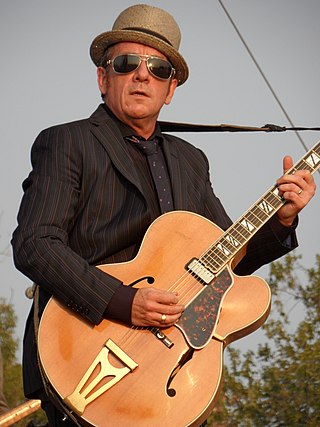
Declan Patrick MacManus, known professionally as Elvis Costello, is an English singer, songwriter, record producer, author and television presenter. Per Rolling Stone, Costello "reinvigorated the literate, lyrical traditions of Bob Dylan and Van Morrison with the raw energy and sass that were principal ethics of punk", noting the "construction of his songs, which set densely layered wordplay in an ever-expanding repertoire of styles." His first album, My Aim Is True (1977), is widely regarded as one of the best debuts in popular music history. It spawned no hit singles, but contains some of Costello's best-known songs, including the ballad "Alison". Costello's next two albums, This Year's Model (1978) and Armed Forces (1979), recorded with his backing band the Attractions, helped define the new wave genre. From late 1977 through early 1980, each of the eight singles he released reached the UK Top 30. His biggest hit single, "Oliver's Army" (1979) sold more than 400,000 copies in Britain. He has had more modest commercial success in the US, but has earned much critical praise. From 1977 through the early 2000s, Costello's albums regularly ranked high on the Village Voice Pazz & Jop critics' poll, with This Year's Model and Imperial Bedroom (1982) voted the best album of their respective years. His biggest US hit single, "Veronica" (1989), reached number 19 on the Billboard Hot 100.

Almost Blue is the sixth studio album by the English singer-songwriter Elvis Costello, and his fifth with the Attractions—keyboardist Steve Nieve, bassist Bruce Thomas and drummer Pete Thomas. It was recorded in May 1981 in Nashville, Tennessee, and released in October the same year. A departure from Costello's previous works, it is a covers album composed entirely of country music songs, including works written by Hank Williams and George Jones. The project originated with Costello's desire to record a collection of covers after his two previous studio albums commercially underperformed following Armed Forces (1979).
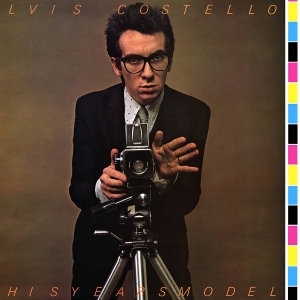
This Year's Model is the second studio album by the English singer-songwriter Elvis Costello, released on 17 March 1978 through Radar Records. After being backed by Clover for his debut album My Aim Is True (1977), Costello formed the Attractions—keyboardist Steve Nieve, bassist Bruce Thomas and drummer Pete Thomas —as his permanent backing band. Recording sessions took place at London's Eden Studios in eleven days between late 1977 and early 1978. Nick Lowe returned as producer, and Roger Béchirian acted as engineer. Most of the songs were written prior to the sessions, and debuted live during the latter half of 1977.

My Aim Is True is the debut studio album by the English singer-songwriter Elvis Costello, originally released in the United Kingdom on 22 July 1977 through Stiff Records. Produced by Stiff artist and musician Nick Lowe, the album was recorded from late 1976 to early 1977 over six four-hour studio sessions at Pathway Studios in Islington, London. The backing band was the California-based country rock act Clover, who were uncredited on the original release due to contractual difficulties. At the time performing as D.P. Costello, Costello changed his name to Elvis after Elvis Presley at the suggestion of the label, and adjusted his image to match the rising punk rock movement.
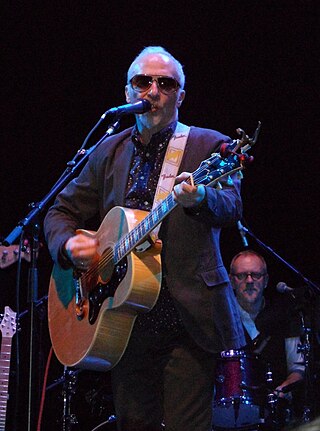
Graham Thomas Parker is an English singer-songwriter, who is best known as the lead singer of the British band Graham Parker & the Rumour.
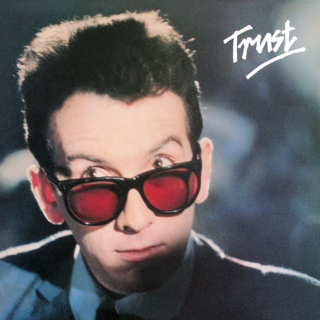
Trust is the fifth studio album by the English singer-songwriter Elvis Costello, and his fourth with the Attractions—keyboardist Steve Nieve, bassist Bruce Thomas and drummer Pete Thomas. It was released on 23 January 1981 through F-Beat Records in the United Kingdom. His fifth consecutively produced album by Nick Lowe, who was assisted by engineer Roger Béchirian, the album was recorded in London from October to November 1980 between DJM and Eden Studios. The sessions were riddled with alcohol and drug issues and tensions were high between the band members. Squeeze vocalist Glenn Tilbrook and the Rumour guitarist Martin Belmont made guest appearances on "From a Whisper to a Scream".
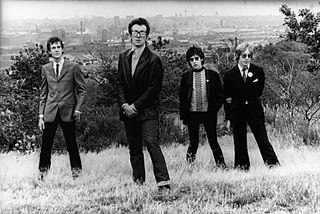
The Attractions were an English backing band for the English new wave musician Elvis Costello between 1977 and 1986, and again from 1994 to 1996. They consisted of Steve Nieve (keyboards), Bruce Thomas, and Pete Thomas (drums). They also released one album as an independent entity, without Costello, in 1980.

"Oliver's Army" is a song written by Elvis Costello and performed by Costello and the Attractions, from the former's third studio album Armed Forces (1979). The song is a new wave track that was lyrically inspired by the Troubles in Northern Ireland and includes lyrics critical of the socio-economic components of war. Costello had travelled to Northern Ireland and was influenced by sights of British soldiers patrolling Belfast. Musically, the song features a glossy production and a keyboard performance inspired by ABBA, creating a juxtaposition between the lyrics and music that both critics and Costello have pointed out.
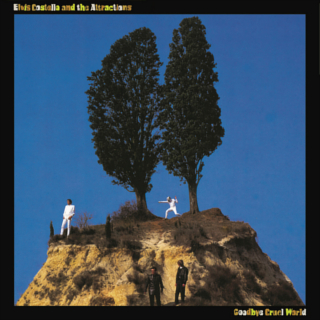
Goodbye Cruel World is the ninth studio album by the English singer-songwriter Elvis Costello, and his eighth with the Attractions—keyboardist Steve Nieve, bassist Bruce Thomas and drummer Pete Thomas. It was released on 18 June 1984 through F-Beat Records in the United Kingdom and Columbia Records in the United States. Produced by Clive Langer and Alan Winstanley, who returned from 1983's Punch the Clock, the album was recorded at London's Sarm West Studios in March 1984 during a period of turmoil for the artist. The problematic sessions included disagreements between Costello and the producers over the album's direction and high tensions amongst the Attractions.

"Radio Radio" is a song written by Elvis Costello and performed by Elvis Costello and the Attractions. The song originated as a Bruce Springsteen-inspired song called "Radio Soul" that Costello had written in 1974. In 1977, Costello reworked the song to feature a more aggressive arrangement and more direct, sarcastic lyrics that criticised the commercialism of British radio. Costello and the Attractions recorded the song around the time of his second album, This Year's Model.
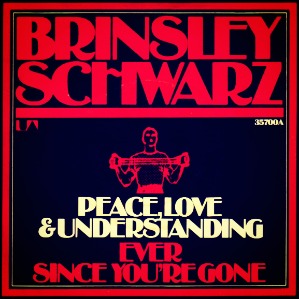
"(What's So Funny 'Bout) Peace, Love, and Understanding" is a 1974 song written by English singer/songwriter Nick Lowe. Initially released by Lowe with his band Brinsley Schwarz on their 1974 album The New Favourites of... Brinsley Schwarz, the song was released as a single and did not chart.

My Flame Burns Blue is the twenty-second album by Elvis Costello, released on Deutsche Grammophon. It consists of recordings from the North Sea Jazz Festival in July 2004, made with Steve Nieve and The Metropole Orkest conducted by Vince Mendoza. It peaked at No. 2 on the Billboard Jazz albums chart and at No. 188 on the Billboard 200.

Live at the El Mocambo is a 1993 live album by Elvis Costello and the Attractions. Recorded on March 6, 1978, from a live radio broadcast by CHUM-FM in Toronto. A tape of the broadcast was obtained by the Canadian division of CBS records and released as an exclusive Canadian promotional album in the same year. As the show's fame began to grow, it became heavily bootlegged.
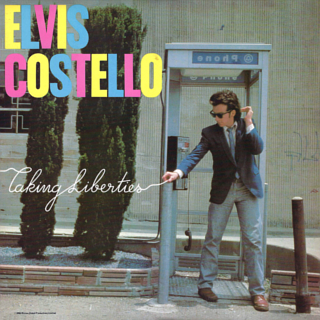
Taking Liberties is a compilation album by English singer-songwriter Elvis Costello, consisting of tracks not previously released on his albums as released in the United States. It is largely made up of B-sides, but features three previously unreleased recordings. It was released only in the US and Canada; its track listing is very similar to that of the UK release Ten Bloody Marys & Ten How's Your Fathers. The differences are that on the latter, the tracks "Night Rally", "Sunday's Best" and "(I Don't Want to Go to) Chelsea" are replaced by "Watching the Detectives", "Radio, Radio" and "(What's So Funny 'Bout) Peace, Love, and Understanding".

The Best of Elvis Costello and the Attractions is a compilation album by English musician Elvis Costello and his backing band the Attractions, released in 1985. It was the first of what would be many career-spanning compilation albums of previously released material for Costello.

"Pump It Up" is a 1978 song by Elvis Costello and the Attractions. It originally appeared on Costello's second album This Year's Model, which was the first he recorded with the backing group the Attractions. Written as an ironic response to his time during the Stiffs Live Tour and inspired by "Subterranean Homesick Blues" by Bob Dylan, "Pump It Up" features a stomping rhythm and ironic lyrics.

The Rumour was an English rock band in the late 1970s and early 1980s. They are best known as the backup band for Graham Parker, whose early records were credited to Graham Parker & The Rumour. However, The Rumour also recorded on their own, releasing three albums: Max (1977), Frogs, Sprouts, Clogs and Krauts (1979), and Purity of Essence (1980).

"(I Don't Want to Go to) Chelsea" is a song written by new wave musician Elvis Costello and recorded by Costello with his backing band the Attractions. The song appeared on Costello's 1978 second album, This Year's Model. Written by Costello while working as a computer programmer, the song was lyrically inspired by films Costello had been watching as well as childhood trips to Chelsea. Musically the song featured influence from bands such as the Who and the Kinks and is notable for Bruce Thomas's prominent bassline.
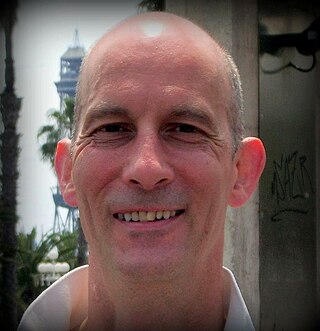
Andrew Bodnar is an English bass player who grew up in Clapham, South London. He and drummer Steve Goulding met and began playing together as a rhythm section while still at school. They spent their teenage years auditioning and busking whenever they could, and were gigging around London with a cajun-influenced band called Bontemps Roulez just prior to forming The Rumour in 1975. Bodnar is probably best known for his membership with Graham Parker and The Rumour (1975-1980), for playing the distinctive reggae-flavored bassline on "Watching the Detectives" by Elvis Costello, and for bass playing and co-writing "I Love the Sound of Breaking Glass" by Nick Lowe.

"Watch Your Step" is a song written by new wave musician Elvis Costello and performed by Costello and the Attractions on their 1981 album, Trust. Originating from lyrics he wrote as a 20-year-old, "Watch Your Step" was inspired by Costello's experiences on tour as well as by dub music. The song was originally a louder rock song, but the final released version is slower and quieter.




















